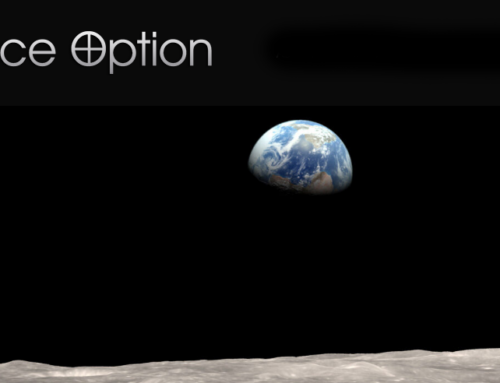Humanity is at a crossroads: we must decide if we prefer to live and prosper in an energy-rich world, or attempt to survive in an energy poor-one. Finding a viable solution to the impending energy and climate crises confronting humanity is urgently necessary. The fundamental causes of these interrelated issues are the many environmental and geopolitical issues associated with the continued use of fossil fuels added to the fact that these are projected to become more problematic to extract, and ever more conflict-prone in the coming years. Policies to reduce energy consumption and inadequate measures currently being implemented by many nations to address these issues will result in energy insecurity. Thus, a sensible transition to a reliable, sufficient and environmentally neutral alternative source of energy is imperative in order to preserve and sustain present civilisation, and to provide future generations with sufficient energy and hope for prosperity and peace.
A feasible near-term solution that has recently become available to humanity for addressing this situation is Space-Based Solar Power (SBSP). This will use modern technologies to harness the inexhaustible solar energy available in the region of ‘Greater Earth’ to supply humanity with the abundant clean energy we will need in the future. Implementing SBSP on the necessary scale, and in a suitable time frame to meet urgent climate and energy goals will require substantial financial investment and global cooperation.
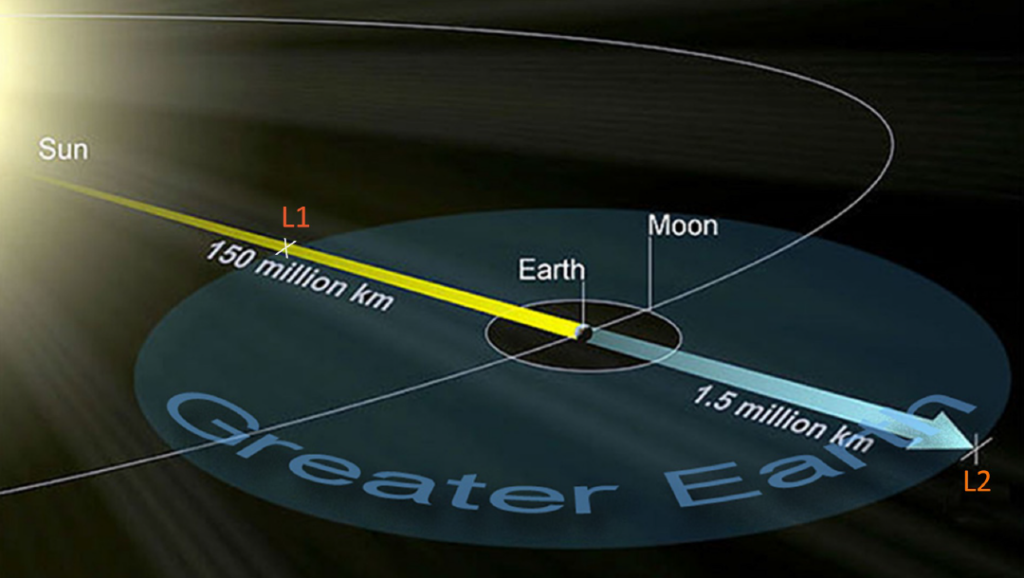
Greater Earth Diagram
Astrostrom’s lunar approach to SBSP estimates infrastructure costs on the order of one hundred billion Swiss francs. As this amount is beyond the means of most companies and even many nations, a multi-national collaborative approach is deemed necessary.
Astrostrom proposes the creation of an international Public-Private Partnership (PPP) to enable SBSP. The primary goal of the Public-Private Partnership is to efficiently provide an inexhaustible supply of environmentally clean energy to the entire world in an equitable, economical, and socially just manner.
The public entity – the Greater Earth Energy Organisation (GEEO) – represents an autonomous multi-national treaty organisation consisting of nation-stakeholders, independent of any other governmental organisation or influence, with a mutual interest to achieve energy security while reaching climate goals.
The private entity – Astrostrom – will comprise a consortium of strategic partners that will be responsible for setting-up and administering the GEEO, and then managing its research and development programmes.
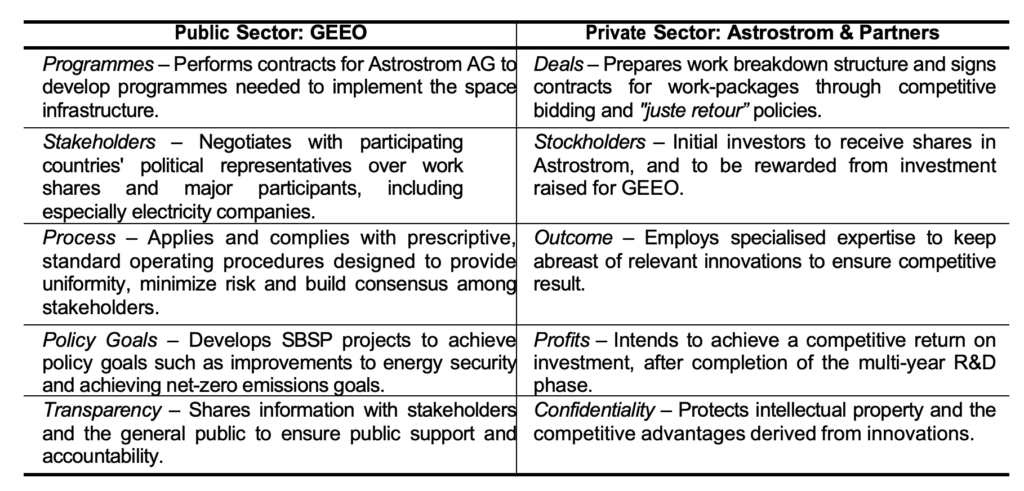
The Greater Earth Energy Organisation (GEEO) is considered as the most promising approach to implementing the Space Energy Option and, by doing so, taking a decisive step towards creating a new worldwide ‘space energy industry’. This approach will de-risk the initial investment while also allowing the GEEO to address the regulatory issues of spectrum allocation, orbital positioning, energy distribution issues, and compliance with international treaties and laws. Of further importance, this collaborative global organisation should become a catalyst for reducing geopolitical tensions over the control and distribution of energy resources, not the least through greatly increasing the supply of energy worldwide.
The amount of 100 billion Swiss Francs (CHF), used as a baseline for the necessary infrastructure investment, comes from the feasibility study conducted by Astrostrom GmbH for the European Space Agency (ESA) in 2022-2023, called the Greater Earth Lunar Power Station (ESA Contract No: 4000136309/21/NL/GLC/ov.). The study detailed an innovative concept for manufacturing Solar Power Satellite (SPS) components from lunar materials. As such, the terrestrial energy market and the need for clean energy are the economic drivers for utilising the resources of the Moon. As a comparison, the US Artemis programme to return Americans to the Moon is reported to cost $96 billion, which may result in many science, technology and exploration benefits, but is not aimed at any specific market or payback objectives (NASA-OIG, 2021).
Compared with the yearly budgets of the European Space Agency – €7.8 billion for 2024 (ESA, Budget, 2024) and NASA’s 2024 budget, – $27.2 billion (NASA, Budget, 2024) – the CHF 10 billion yearly budget of the GEEO is between the budgets of these two space agencies. Whereas these space agencies are mandated to develop numerous space technologies and exploration programmes, the GEEO will be focused on providing clean energy from space.
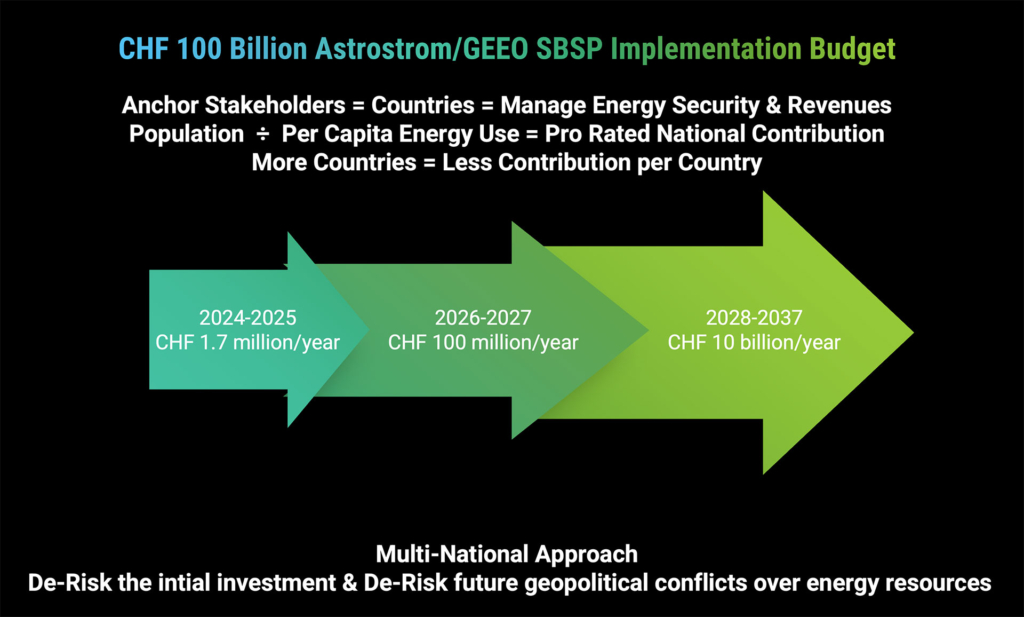
In Phase 1, 2024-2025, Astrostrom will assemble a dedicated team of space, energy, legal, and lobbying experts who will prepare the rationale, the legal infrastructure and the marketing tools for convincing and enlisting the member nations to join the GEEO. To do this it will need to hire additional personnel and establish facilities.
Phase 2, 2026-2027 begins once the GEEO has been set-up and specific research and development programmes have been selected for development. It will have a planned yearly budget of CHF 100 million for the research and development activities. In partnership with the GEEO, Astrostrom and its strategic partners will manage the technology development and implementation of SBSP as well as the administrative tasks of the GEEO consortium.
Phase 3, 2028-2037 is the implementation period based on the results of the research and development of the previous phases. Astrostrom and its strategic partners will continue to manage and direct the technology development and implementation of the SBSP programmes and manage the administration of the GEEO. To implement SBSP, the GEEO should have a yearly budget of CHF 10 billion.
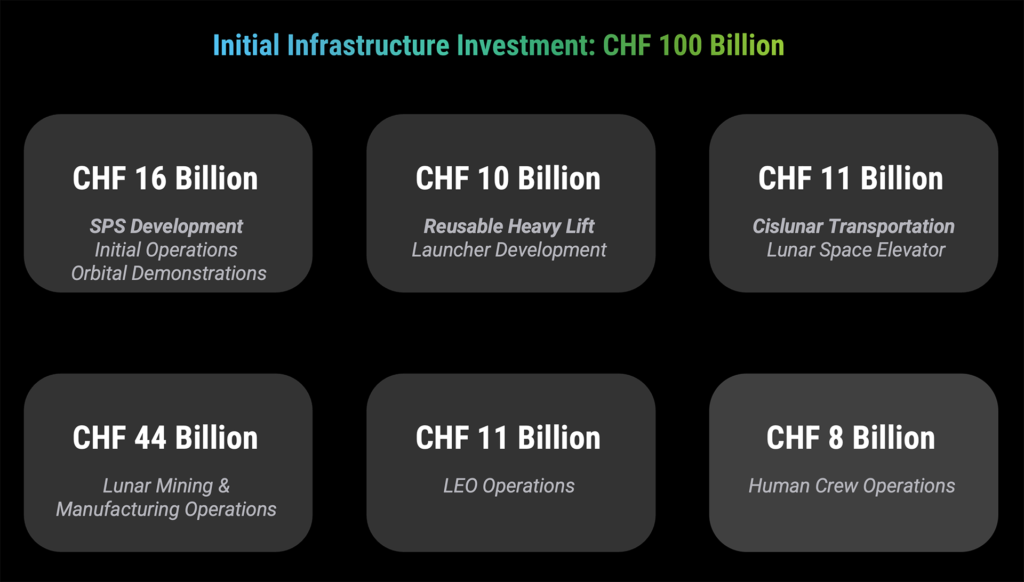
The anticipated CHF 100 billion to develop the necessary technology and infrastructure has been itemized in Astrostrom’s Greater Earth Lunar Power Station (GE⊕-LPS) Final Report to ESA.
- CHF 11 billion will be used for Low Earth Orbit (LEO) operations including a Cargo Relay Station and test platform in low equatorial orbit. This will be used as a logically convenient site for preliminary testing of SPS components and as a way station to GEO and lunar orbits.
- CHF 16 billion is earmarked for Solar Power Satellite development. This includes support for any current SPS technology or project that is considered viable or compatible with GEEO’s overall goals.
- CHF 10 billion is earmarked for the development of a heavy-lift reusable launch system with the capability to send large payloads to GEO and to the Moon. Currently Starship is being developed by SpaceX in the US and the Long March 9 in China. A heavy lift launcher code-named PROTEIN is being studied by ESA with two concepts under consideration by ArianeGroup and Rocket Factory Augsburg. Ensuring access to space using reusable vehicles is considered essential for the economical implementation of SBSP and the deployment of Solar Power Satellites. (ESA: PROTEIN, 2023)
- CHF 11 billion is earmarked for the development of the Cislunar Transportation System including Cislunar shuttles, a Lunar Landing Gantry, and a Lunar Space Elevator. (Astrostrom: LSE, 2023)
- CHF 44 billion will be used to develop and deploy lunar manufacturing and mining operations. Existing terrestrial technologies will be adapted to the lunar environment and modularized for transport to the Moon.
- CHF 8 billion will be used for human crew operations and facilities in orbit and on the Moon.
The GEEO Concept
The GEEO will be established as an autonomous not-for-profit multi-national treaty organisation. The main advantage to having such an organisational and legal structure will be to avoid conflict or destructive competition between nations, and to provide a transparent process for the development and eventual distribution of this new space energy resource. The approach will also make the GEEO compliant with existing international space treaties and accords.
As technological and economic progress are closely correlated with per capita energy consumption, there is a close fundamental correlation between the stage of development of a country and its energy consumption. Developed countries have the highest per capita consumption of energy. Poorest, least developed countries have the lowest per capita consumption.
To achieve, as far as possible, a fair participatory plan reflecting the energy procurement and development process, and to stimulate energy use responsibility, each member’s contribution to GEEO will be determined by an efficiency coefficient that is based on its population and its per capita energy consumption. A country with a high per capita consumption of energy and a small population would contribute correspondingly more into the GEEO budget than a country with a large population and lower per capita energy consumption calculated on a per capita basis.
Video (3:37 min.) produced for the International Conference on Energy from Space
Organised by the Royal Aeronautical Society and the European Space Agency
London, 17-19 April 2024
Although all nations are welcome to join the GEEO, the initial target nations are those nations with existing space agencies or space programmes. In 2023, 74 different government space agencies are in existence, including 68 national space agencies and six international agencies. These space agencies include ESA with 22 full members and 9 associate members. The African Space Agency includes 55 member states of the African Union. Some of the members of these agencies have their own national programs. Another 28 nations are considering establishing their own space agency. Considered to be the most likely candidates, all of these nations will be contacted and invited to join the GEEO (Wikipedia, List of government space agencies).
However, any nation may join the GEEO. The first nation to join the GEEO will become the Anchor Stakeholder and will be the first country to contribute to the GEEO budget. This nation would sign a ‘Partnership’ contract with Astrostrom which officially establishes the PPP arrangement and establishes the parameters for subsequent member nations. Having an Anchor Stakeholder will help to attract and motivate other stakeholders to join the GEEO.
The GEEO will be modelled on existing and established international organisational examples as a dedicated collaborative approach to implementing SBSP. Ideally, the GEEO should be based in a neutral country with a credible regulatory framework. For political, legal and economic considerations, an ideal nation for locating the GEEO would be Switzerland which hosts more than 40 international organizations with over 25,000 staff. These include international organizations such as the IOC. The International Olympic Committee (in French, Comité International Olympique CIO) and FIFA (Fédération Internationale de Football Association) have their headquarters in Switzerland, and both are registered as “associations” which, under Swiss law, allows them to have a tax-free status if requested. Both organizations manage budgets amounting to billions of dollars. Other examples are the World Health Organization (WHO), the Bank for International Settlements (BIS), and the World Economic Forum (WEF), some of which have additional diplomatic privileges. However, other nations may wish to host the GEEO.
Any nation may join GEEO and participate in the GAP (General Assembly of Partners). The GAP will meet regularly and together with Astrostrom, determine its immediate development goals and set a corresponding yearly budget to achieve these goals. A yearly congress including member nations, their technology sectors that have become involved, and Astrostrom’s strategic partners will exchange information, discuss challenges and solutions, and plot the needed research and development.
GEEO Budget Scenarios
It is useful to use Switzerland’s yearly contribution to the European Space Agency budget as a reference for illustrating GEEO budget scenarios using the efficiency coefficient. Reference: ESA’s budget for 2024 is €7.79 billion and Switzerland’s contribution is €188.2 million which is approximately 3.6% of the overall ESA budget.

ESA 2024 Budget (Screenshot from the ESA website)
Adhering to a concept of fair return and geographical distribution, an equal percentage (90%) of a country’s yearly contribution to GEEO will be re-invested in that country through contracts that are placed with its local industries and organisations. With a larger number of participating member countries, the budget can be larger while the per country contribution will be smaller.
The GEEO budget tables below incorporate the efficiency coefficient for each country to calculate their yearly contribution to the GEEO.The first two tables use the ESA members and associate countries. ESA comprises 22 Member States and 9 countries with cooperation agreements (ESA, Member States & Cooperating States). The last two tables incorporate data from 42 countries from different regions of the world.
The data was obtained from:
Our World in Data: Population 2021
https://ourworldindata.org/explorers/population-and-demography
Our World in Data: Primary energy consumption per capita 2022
https://ourworldindata.org/grapher/per-capita-energy-use
CHF 100 million yearly budget with ESA members & associate nations
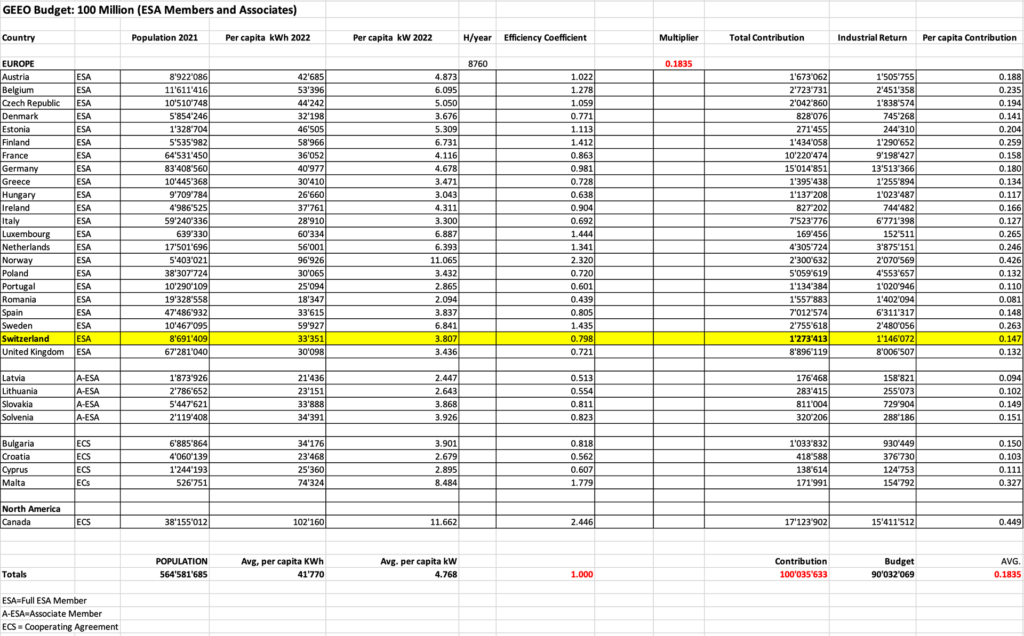
CHF 100 million/year GEEO budget (ESA Member States). Average per capita contribution = CHF 0.194
Switzerland’s projected yearly contribution = CHF 1,273,413.
90% or CHF 1,146,072 would flow back to Switzerland’s industries.
CHF 10 billion yearly budget with ESA members & associate nations
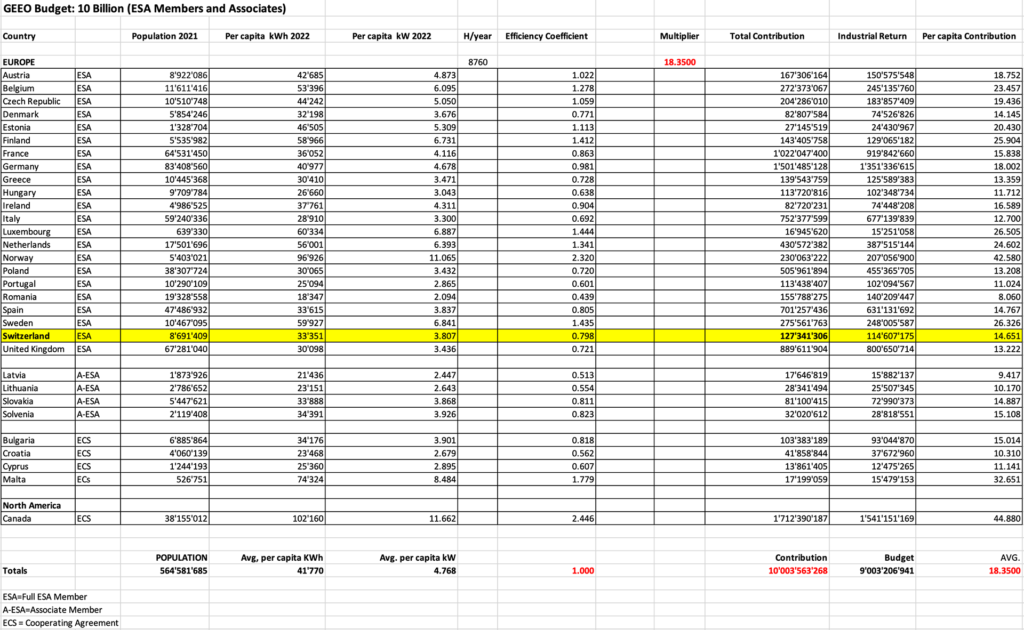
CHF 10 billion/year GEEO budget (ESA Member States). Average per capita contribution = CHF 19.20
Switzerland’s projected yearly contribution = CHF 127,341,306.
90% or CHF 114,607,175 would be allocated to Swiss industries.
CHF 100 million yearly budget 42 GEEO member nations
CHF 100 million/year budget with 42 GEEO member countries. Average per capita contribution = CHF 0.043
Switzerland’s projected yearly contribution = CHF 284,732.
CHF 256,259 represents the fair return.
CHF 10 billion yearly budget with 42 GEEO member nations
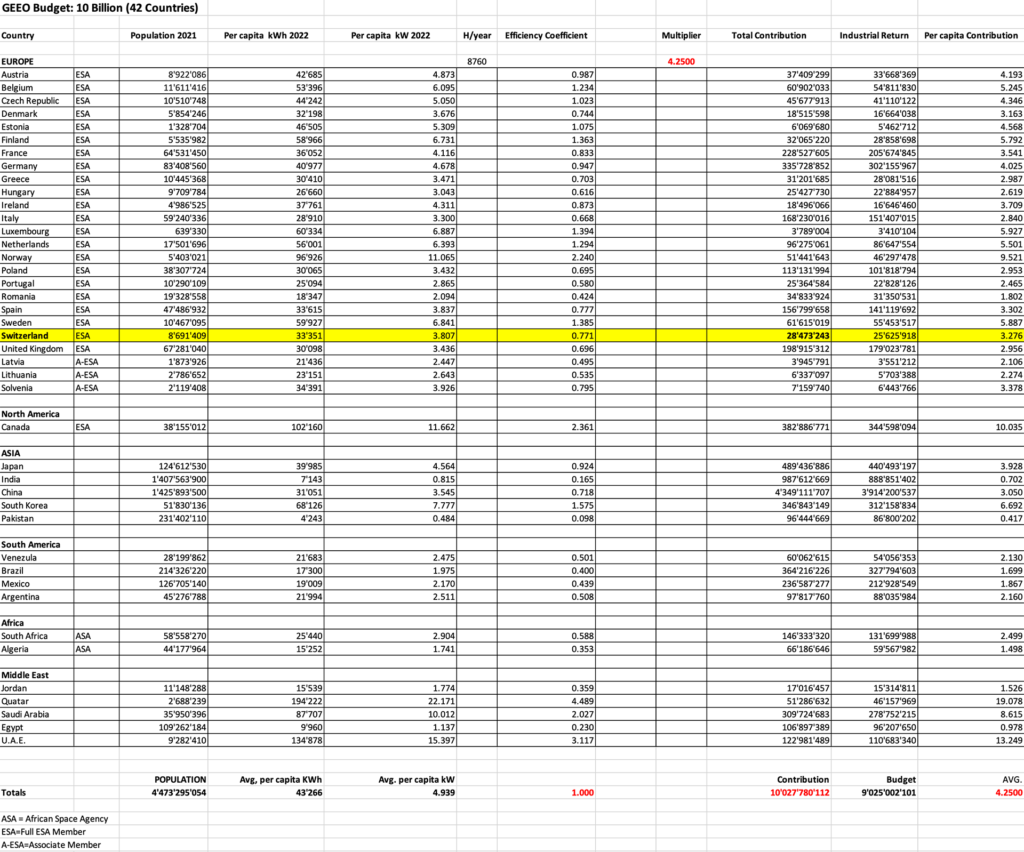
CHF 10 billion/year budget with 42 GEEO member countries. Average per capita contribution = CHF 4.20
Switzerland’s projected yearly contribution = CHF 28,473,243.
Fair return = CHF 25,625,918.
As mentioned above, the anticipated implementation budget of the GEEO in the amount of CHF 100 billion to develop the necessary technology and infrastructure has been itemized in Astrostrom’s GE⊕-LPS Final Report to ESA. An initial investment of CHF 100 billion should not seem unreasonable if it can solve humanity’s energy and environmental issues, while generating major new economic opportunities and stimulating peaceful cooperation worldwide.
While humanity is indeed at a crossroads, it is also on the threshold of transforming the energy-constrained Fossil Fuel Age into the energy-abundant Space Energy Age.
ASTROSTROM is seeking strategic partners and investors to set up the Greater Earth Energy Organisation (GEEO) to implement SBSP.
If you are interested to profit from this unprecedented opportunity, please send us an inquiry.
References:
- ESA, 2024 Budget: https://www.esa.int/About_Us/Corporate_news/Funding
- ESA, PROTEIN: https://commercialisation.esa.int/2023/05/protein-the-new-european-heavy-lift-launcher-study/
- NASA, 2024 Budget: https://www.nasa.gov/nasa-fiscal-year-2024-budget-request/
- NASA-OIG. (2021). Artemis Status Update. Office of Inspector General. https://oig.nasa.gov/docs/IG-21-018.pdf
- GE⊕-LPS Final Report (2023) (ESA Contract No: 4000136309/21/NL/GLC/ov.) https://astrostrom.ch/docs/GE⊕-LPS-Final-Report_June_2023.pdf
- ESA: Lunar Solar Power Satellite 2023: https://www.esa.int/ESA_Multimedia/Images/2023/07/Lunar_solar_power_satellite
- ESA: Announcement of GE⊕-LPS study on LinkedIn: https://lkdin.io/4ANI
- ESA: Nebula Archive: https://nebula.esa.int/content/ge%E2%8A%95-lunar-power-station
- ESA: Members States & Cooperating States
https://www.esa.int/About_Us/Corporate_news/Member_States_Cooperating_States - Our World in Data: Population 2021
https://ourworldindata.org/explorers/population-and-demography - Our World in Data: Primary energy consumption per capita 2022
https://ourworldindata.org/grapher/per-capita-energy-use - Wikipedia: List of government space agencies:
https://www.wikiwand.com/en/List_of_government_space_agencies







